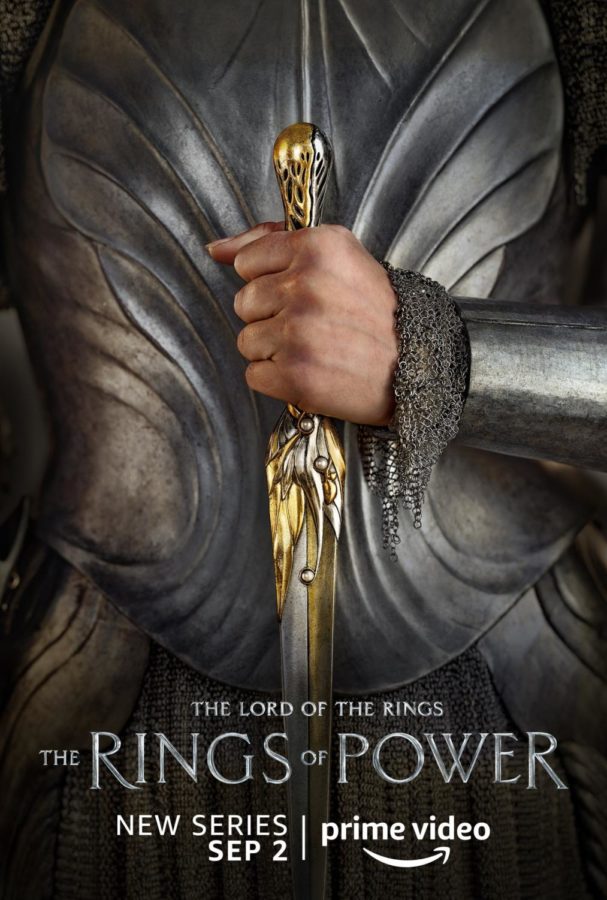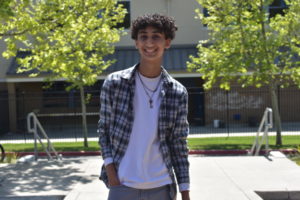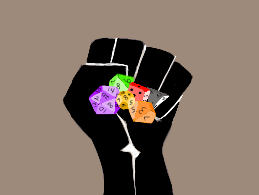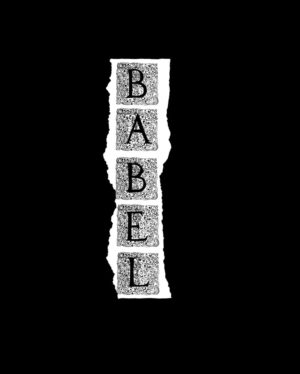“Rings of Power” falls short of enhancing Tolkien’s world
IGN
The three Elven rings form the crux of Amazon Prime’s latest series, “The Lord of the Rings: The Rings of Power.” The series explores the events leading up to the creation of the Three Rings, containing mysteries as to what force of darkness may be returning over Middle-Earth.
November 7, 2022
“The Lord of the Rings: The Rings of Power,” Amazon Prime’s new prequel-style series that takes place before the events of J.R.R. Tolkien’s “Lord of the Rings” (LOTR), released on Sept. 1. Running for eight episodes until Oct. 14 and produced by first-time showrunners J. D. Payne and Patrick McKay, the series drew in Tolkien fans for the potential of new storylines and further exploration of the LOTR world. However, the series not only missed out on the intricacies of Tolkien’s universe, but it also dragged out the exciting premise into a disappointing ending.
“Rings of Power” is set approximately 2000 years prior to Lord of the Rings. The series creates several unique storylines involving characters old and new, attempting to connect the lore that Tolkien wrote about his own universe into a compelling backstory for why the Rings of Power were forged. No LOTR knowledge is needed to enjoy the series, though it’s worth knowing that in “Lord of the Rings,” these rings are the source of much mayhem. However, Rings of Power doesn’t even need any rings to become a whirlwind of chaos and adventure.
Right off the bat, the audience is introduced to several separate plots that follow characters from different regions of Middle-Earth: the dwarf prince Durin in the Misty Mountains, his friend Elrond of the Elf Council in Lindon, elf commander Galadriel’s search for vengeance, and an innocently adorable breed of hobbit ancestors known as the Harfoots. Later in the series, the island kingdom of Numenor and a human village in the Southlands are introduced and become a significant stage for the story.
Not many of these stories intersect, which is nice for viewers who already have enough to keep track of. However, they are distinct in their own right, largely due to the characters being meticulously well-written in all their complexities. Each character fits well in their settings, and the decisions they make seem natural to their dispositions. For example, Galadriel is an elf consumed by vengeance — but the righteous kind. As a result, when she jumps from a ship that’s basically meant to deliver her to eternal life as a reward for all her warrior deeds, just so she can swim back to the grittiness of Middle-Earth and finish her hunt for Sauron, it’s more pleasantly revealing than cheesy. Her spur-of-the-moment deed, as dramatized as it is, only emphasizes the magnitude of the elf’s bravery and conviction, putting viewers on her side.
Another appealing storyline was that of the Harfoots. It’s in the diminutive Harfoots that we find our favorite storyline: Nori and the stranger. Nori is a lovable sweet protagonist, almost childlike, who starts to look after a grown male stranger that she comes across while investigating a fallen comet. This was one of the sweetest friendships in the series, as the small Harfoot risks her life multiple times to keep the stranger safe, despite the rest of the Harfoot tribe’s distrust of him. Turns out, small nature creatures that take care of others? It’s a refreshing break from all the usual questing, back-stabbing tirade, and each time Nori came on screen, her innocent and caring nature was frankly a breath of much-needed wholesomeness that made the series much more enjoyable.
Though initially, it’s exciting to trace the characters’ journeys across the series, “Rings of Power” fails to answer many of the questions it sets up, leaving the audience stymied by a distasteful mixture of confusion and predictability. This is in large part due to its hinting at the stranger being Sauron (and Sauron’s disciples claiming so), but instead an “unexpected” switch-up in the last episode that left some viewers wondering the significance of the first seven.
It’s also in part due to the complicated, near-apocalyptic events in the middle of the series, when the plot takes a noticeable dip in thoughtfulness. When the orcs prepare to invade the human village of the Southlanders, the series shows us the kingdom of Numenor gearing up across Middle-Earth to save them, and so it’s obvious that the Southlanders are really not in that much peril. And what’s more, the orc enemy itself is a bit hackneyed, as the times they do wreak havoc is dramatically drawn-out when their clear outnumbering of the villagers should have caused the fight to end quickly.
To its benefit, “Rings of Power” also participates in grandiloquent world-building. The architecture of the elven kingdoms soars high above forested hills and is bathed in golden light, while the meadows that house the Harfoots seem surrealistically green and plush, looking like a nature haven. The impressive tonal contrasts done through the world-building helps visually depict some of the contextual lore. For example, the mortal village of the Southlanders is a grim place to live, sky and field bathed in sickly gray and green colors. The houses are constructed with rotting wood and overseen by a formidable stone watchtower, and it’s a helpful visual cue that the villagers are toiling in a state of suffering. Then, as the series introduces the human kingdom of Numenor in later episodes, it’s a stunning contrast. The granite archways of blue and gold insignia and large statues that dominate the idyllic island kingdom create a refined, noble atmosphere of prosperity. The Numenorians had sided with the elves during wars past, resulting in their lavish kingdom. The men who sided with Morgoth — and subsequently, Sauron — are left with pitifully bleak ruins, a contrast the series sets up and executes well.
Overall, the producers create a lush and richly imagined depiction of Tolkien’s world, and it’s truly a visual feast for the eyes. And yet — one can’t help but feel that there’s more to be explored. One of the best things about a LOTR-universe series is that viewers and fans of the book can actually harmonize the mind-tingling descriptions in the books with settings and scenery that can be seen on screen. It’s the dream of anyone who’s spent hours immersing themselves in fantasy books — the idea that a huge budget and willing producers can take the beautiful literary world of Tolkien and reproduce it into a moving image before their eyes.
However, the series tends to slap “buzz-word” locations onto the screen and then leave without exploring more of the intricacies. The show depicts the elf kingdom of Lindon, the Misty Mountains and fields and rivers far and wide across Middle-Earth. The characters receive their fair share of action in all these locations, allowing for glimpses of sun-dappled forest and soaring mountains. But the series failed to give viewers a chance to look around the world for themselves. As humble viewers who cannot physically walk the bridge over the waterfalls of Lindon, inhale the damp smoke of the Misty Mountains or ride a horse along Numenor’s western shores, the series was a chance to live vicariously in Tolkien’s world. But when the series favored action sequence after action sequence, plotting after planning after emotional reunion, the world felt a little too much in the background when it is in fact the highlight of many a Tolkien fan’s reading experience.
The growing banality of the plot also made the show less enjoyable to watch. The inevitable plot armor of all our main heroes made scenes of peril seem dragged out and redundant. Perhaps the most compelling fight of the series was when human villager Bronwyn and her son Theo first discovered the dangers of the orcs. As viewers, we weren’t entirely acquainted with the orc enemies yet, so the disturbing images of black claws curling over the rim of a trapdoor, the orc’s head clad by a witch doctor-esque skull, was a truly jarring and edge-of-the-seat experience. From then on, however, the orcs multiplied into one rowdy mass and it was like indistinguishable CGI, purely extraneous additions of violence to meet the fantasy-war quota.
But of course, all the orcs bow to the one true Sauron, the mysterious villain and source of Galadriel’s vengeance. In the TV series, Sauron, though omnipresent, is not very well set up. He plays a much larger role as the main force of darkness in “Lord of the Rings.” However, the prequel series made viewers guess at who was really Sauron and, needless to say, when the showrunners revealed who they chose to pin the name of Sauron on? It was a twist that felt extraneous, unnecessary and invalidated much of that character’s growth and their camaraderie with others throughout the series.
The result is that Sauron’s oppressive evil in “Lord of the Rings,” and the backstory behind characters whose stories continue in the book series, felt stunted rather than fleshed out by the prequel. And so, “Rings of Power” doesn’t set up for “Lord of the Rings” very well.
The Rings of Power falls into the conundrum of too many big-budget shows in recent years: magnificent CGI, but porous plot. The plethora of plot inefficiencies truly takes away from a show brimming with potential, one that attempts to reveal truths about trust, camaraderie and honor. Instead, the show’s scrupulous storytelling leaves little room for a clear and powerful delivery.
If you are truly looking for a good fantasy series to spend your weekend with, we recommend you simply turn to Tolkien’s own writing, and read the books.







